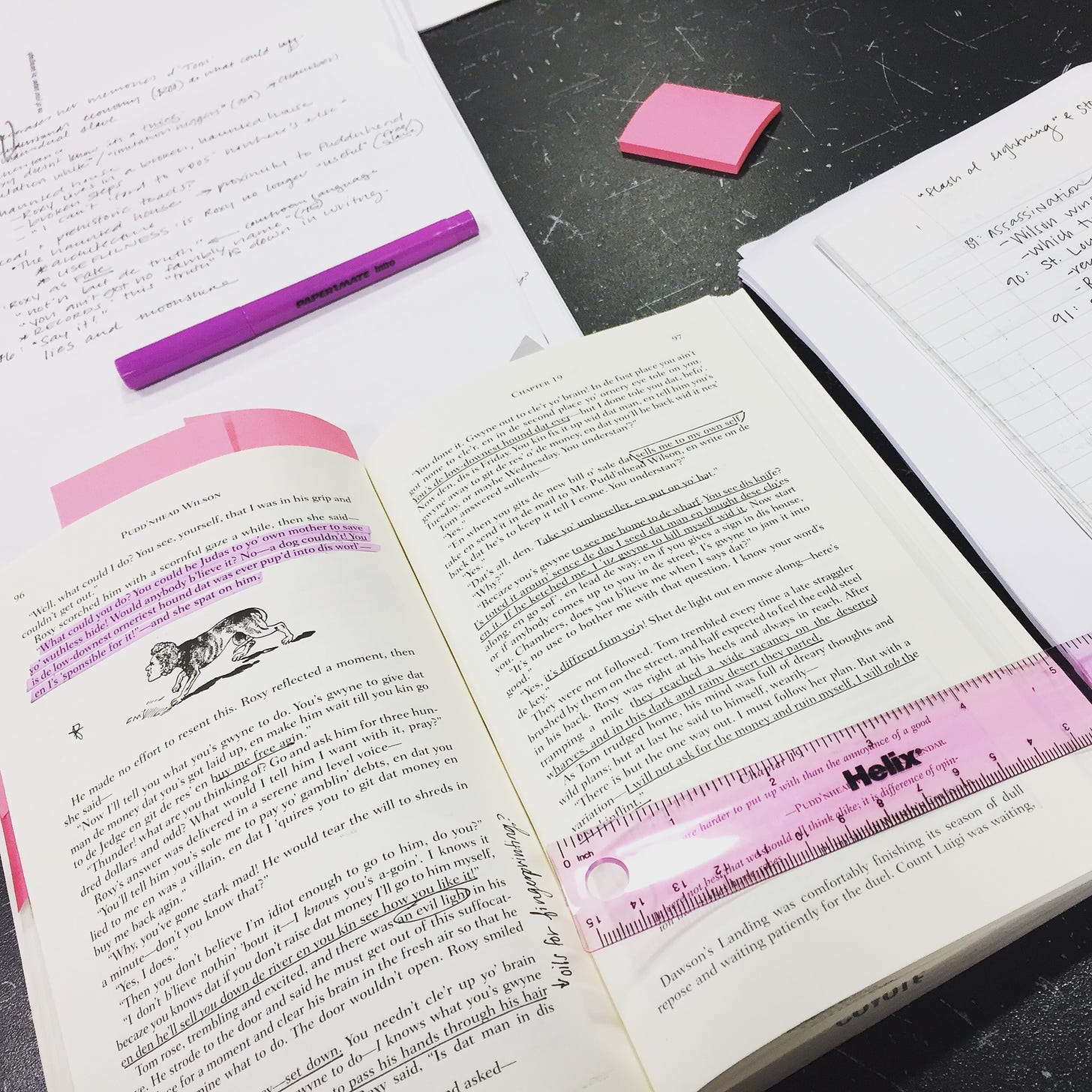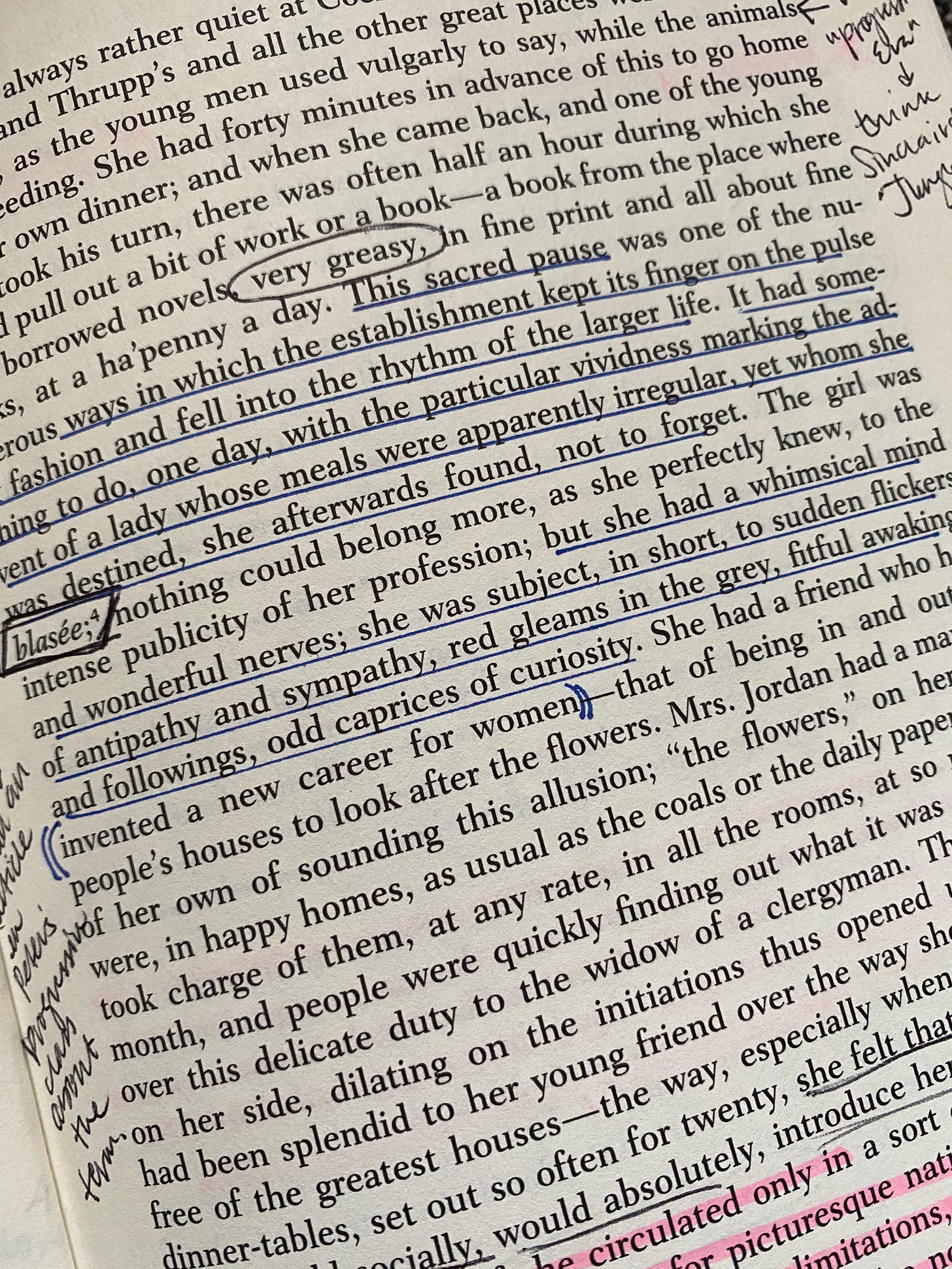how to: get better at close reading
[Try these 5 tips to become a better close reader, no matter what you're reading right now.]
Last week, I wrote about what close reading is and why you might want to try it. Today, I’m sharing 5 easy tips to deepen your close reading practice. As a literature scholar, I sometimes forget how second nature my own close reading practice has become. Kate Jones, who writes the lovely “A Narrative Of Their Own” commented on my last post that “I think once you've been a literature student, it's sometimes actually harder not to close read texts!” and I couldn’t agree more.
The definitions and tips I’ve put together here are my attempts to dissect my own close reading process, and to offer some insight into how you can emulate what I’ve found to be a really successful approach to closely reading everything from esoteric modernist prose to advertising headlines.
First, two reminders:
1. Close reading is active
You’re tracking and seeking as you read. Rather than gliding along through a narrative, active close reading ramps up your focus level so you can track patterns in the story and seek out new information and patterns as you go. Once you’ve noticed a pattern, look for moments when it is reinforced, as well as moments when it breaks.
For example: if we learn early on in Anne of Green Gables that Marilla is a reserved and cold personality, what do we make of her warmer moments toward Anne?
Think about the lines a story draws around its characters — and watch for the moments it stretches or crosses those lines.
2. Close reading is engaged
This means you’re moving intentionally and deliberately through a piece of writing and that starts by identifying some kind of purpose. Maybe you want to understand a historical moment better, to grapple with a new genre like science fiction or literary fiction, or even to try connecting with an author you’ve never read before.
Whatever your goals are, they should remain top of mind as you read. When you know why you’re doing something, it’s often a lot more interesting to do that thing.
Okay: now for some concrete tips. Try these the next time you sit down to read.
TIP 1: Find a focused posture.
Your body positioning and posture change when you actively read. You may adopt a less leisurely posture while you closely read, because you’re shifting the intention of your energy into the book, rather than expecting the book to transfer all the effort out onto you. So, find a position that allows your energy to pour into the text in front of you and really focus on your reading.
Try this: Find a new reading space! You might find that reading at your kitchen table or desk feels really good while you’re closely reading because it shifts your mind from “relaxation” to “focus” mode. It might feel a little like doing homework — and that’s not necessarily a bad thing.
TIP 2: Read when you’re wide awake.
I learned very quickly during my PhD that if I was tired at all during a close reading session, I would miss key details and wouldn’t get very much out of my notes during class.
Many of us read before bed or while we’re sitting in a waiting room: spaces filled with distractions and other reasons for being there. If these are where you do most of your reading, no wonder you can’t remember anything you read! Make “close reading” your sole activity for the time you have.
Try this: Read at an optimal time for your mind. Some of us are more wakeful in the morning or very late at night. I know it’s easy for work and family and, well, life to get in the way. So, identify the hours you feel your most focused and awake and give yourself 30 minutes to read during that time, if you can.
If you absolutely can’t read during your best brain-time, set yourself up for success during the time you do have with your favorite drink, good lighting, and good background noise. (I love to watch “cozy reading nooks” or a good Hogwarts Library background, free on YouTube.)
TIP 3: Write down your reading goals!
I used to do this before every reading session until it became more of a quiet, internal habit. Now, I always have a goal in mind while I closely read.
Consider writing down the themes you want to track, ideas you’re looking for, or general purposes for closely reading on a Post-it note and stick them right on the book’s cover or, better yet, use them as a bookmark as you read.
Caveat: One of the most pleasurable things about reading is being surprised by a story or a character. Avoid becoming so “intentional” that you’re fishing for a book to give you something it may not be responsible for giving you. Leave room in your mind for a book to do something you weren’t expecting or looking for.
TIP 4: Start developing an annotation style.
I’ll be writing more about how to annotate a text very soon. But here’s the basic idea: close reading is based on your observations about a text and your interpretations and questions about those observations. So, annotation—the act of taking notes while you read by underlining, circling, starring, or writing comments in the margins or in a separate notebook—is simply a method of collecting your observations.
Some folks absolutely refuse to write in their books. If that’s you: try keeping a reading log or journal with you as you read. Write down (or type up!) anything you observe, along with the page number you observed it on, as you go.
For those who are okay with writing in their books (or absolutely love it, as I do), consider the tools you use and how much you’ll be revisiting your copy of this book in the future. Do you want to use a pencil to leave lighter marks? Do you want to use a key or legend, establishing your own annotative language as you read? If you’ll be underlining a lot, would a ruler help keep those lines sharp?
TIP 5: Let go of the idea of the “right” answer.
Many students and friends have told me they are jealous that I have an English PhD because I probably know “the right way to read a book.” What they usually mean is that they’re assuming my educational background means I have access to answers and ideas they do not have any access to. Yes, having the educational background and training means that I’ve spent years of immersive and intensive study developing my analytical style.
But this is why close reading is so amazing: by engaging deeply and critically with a literary work, you give yourself access to a mode of analysis which is a fancy way of saying “ a new way of thinking.”
Caveat: This doesn’t mean that you can read anything into any text — that’s an issue of both fairness and interpretation. But it does mean that the way you close read a text is different from the way your best friend or favorite professor close reads a text, and the differences are proof of the depth and wealth of ideas that great literature brings to us.
Close reading is available to you, whether you have literary training or not. All you need to start closely reading is a book, a pen, and your wonderful brain.
Close reading is ultimately guided by your willingness to observe what is happening in a book and to notice yourself noticing those things, so you can ask questions about them. Ready to give it a go?







I love many of your ideas here! Although I have practised close reading for years now, I still find that I get easily distracted, unless I go to a library or study space. When I was a student I found it easier because I had papers to write. I also often try to read in the evenings when all other tasks are done but am then too tired to fully engage. I love your idea of finding a place for close reading, and am going to try reading (for research/close reading) at the kitchen table more, as well as at a different time of day. I will also try using a ruler as you suggest.
Also, I am a big fan of writing in books! One of the best things is going back to them years later and rediscovering your notes : )